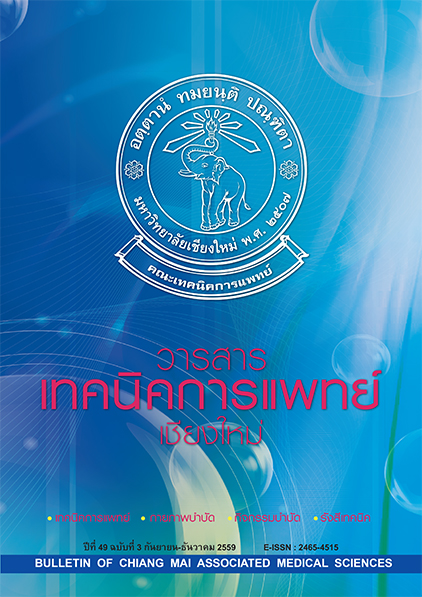The effects of yoga training on chest wall expansion and respiratory muscle strength in female subjects
Main Article Content
Abstract
Background: Yoga is a type of exercise with breathing control, which has effect on increased flexibility of muscle, improvement of cardiorespiratory function, and stress reduction.
Objectives: To determine the effects of yoga training on chest wall expansion and respiratory muscle strength in female subjects.
Materials and methods: Twenty-five female participants were recruited in this study. The participants completed a 6-week yoga training consisted of 30 minutes a day for 3 days a week session. The chest wall expansion was measured before and after yoga training by standard tape at the upper, middle, and lower level of thorax. All participants were measured for muscle strength of both maximal inspiratory pressure (MIP) and maximal expiratory pressure (MEP).
Results: Participants demonstrated a significant increase in mean differences of chest wall expansion after yoga training. The mean differences between pre and post training for the upper, middle, and lower chest wall was 0.89±0.58 cm (p<0.01), 1.27±0.57 cm (p<0.01), and 0.81±0.89 cm (p<0.01), respectively. The MIP and MEP were increased significantly after yoga training (p<0.05).
Conclusion: Chest wall expansion and respiratory muscle strength has been improved by undergoing yoga training 30 min/day and 3 days/week for 6 weeks.
Bull Chiang Mai Assoc Med Sci 2016; 49(2): 363-369. Doi: 10.14456/jams.2016.32
Article Details
Personal views expressed by the contributors in their articles are not necessarily those of the Journal of Associated Medical Sciences, Faculty of Associated Medical Sciences, Chiang Mai University.
References
2. Monro R. Yoga therapy. J Bodywork Mov Ther 1997; 1: 215-8,.
3. Madanmohan, Thombre DP, Balakumar B, Nambinarayanan TK, Thakur S, Krishnamurthy N, et.al. Effect of yoga training on reaction time, respiratory endurance and muscle strength. Indian J Physiol Pharmacol 1992; 36(4): 229-33.
4. Javnbakht M, HejaziKenari R, Ghasemi M. Effects of yoga on depression and anxiety of women. Complement Ther ClinPract.2009; 15(2): 102-4. doi: 10.1016/j.ctcp.2009.01.003.
5. Hadi N1, Hadi N. Effects of hatha yoga on well-being in healthy adults in Shiraz, Islamic Republic of Iran. East Mediterr Health J 2007; 13(4): 829-37.
6. Williams KA, Petronis J, Smith D, Goodrich D, Wu J, Ravi N, et.al. Effect of Iyengar yoga therapy for chronic low back pain. Pain 2005; 115(1-2): 107-17.
7. Kurwale MV, Gadkari JV. Effect of yogic training on physiological variables in working women. Indian J Physiol Pharmacol 2014; 58(3): 306-10.
8. Vedala SR, Mane AB, Paul CN. Pulmonary functions in yogic and sedentary population. Int J Yoga 2014; 7(2): 155-9. doi: 10.4103/0973-6131.133904.
9. D’Souza CD, Avadhany ST. Effect of yoga training and detraining on respiratory muscle strength in pre-pubertal children: a randomized trial. Int J Yoga 2014; 7(1): 41–7. doi: 10.4103/0973-6131.123478.
10. Chanavirut R, Khaidjapho K, Jaree P, Pongnaratorn P. Yoga exercise increases chest wall expansion and lung volumes in young healthy Thais. Thai Journal of Physiological Sciences 2006; 19(1): 1-7.
11. CoelhoCM, LessaTT, Coelho LAMC, da Silva Scari R, Novo JMN, de Carvalho RM. Ventilatory function in female practitioners of hatha yoga. Rev Bras Cineantropom Desempenho Hum. 2001; 13(4): 279-84. doi: 10.5007/1980-0037.2011v13n4p279


